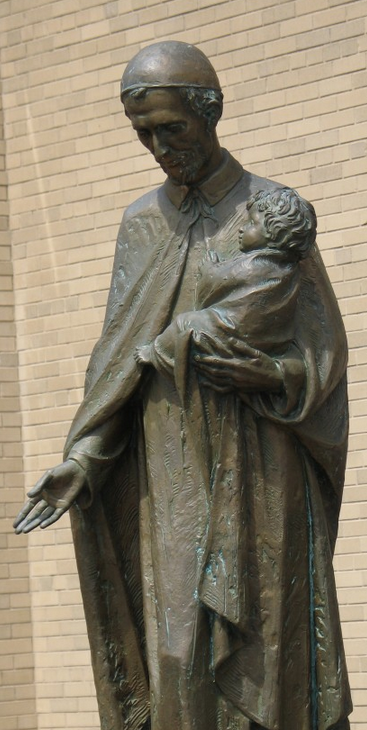Pat Griffin “reads” a St. Vincent statue
 Pat Griffin “reads” a St. Vincent statue – As part of an ogoing series of articles “A Vincentian View” for the St. John’s University student newspaper, The Torch, he offers his reflections and background on a statue student walk by each day.
Pat Griffin “reads” a St. Vincent statue – As part of an ogoing series of articles “A Vincentian View” for the St. John’s University student newspaper, The Torch, he offers his reflections and background on a statue student walk by each day.
A Vincentian View
Fr. Patrick J. Griffin, CM
“A Statue of St. Vincent”
Tucked into the corner where Newman Hall makes its right angle, just off the great lawn, stands a statue of St. Vincent de Paul. For those of us familiar with the Vincentian spirit, statues like this are as well-known as family photos. They capture something of the man and his missionary heart.
Our statue has Vincent carrying a single infant. If you head over to St. Thomas More Church and look at the stained glass window to the left of the main entrance, you will see a similar image. And, if you enter the Church and look up at the beautiful mosaic just above the door to the Church proper, you will see a third presentation of Vincent holding a child. Thus, three media (statue, stained glass and mosaic), only a short distance from each other, enable us to see Vincent in this characteristic stance of protection and concern. (Our Staten Island Campus has many such representations.)
A story about Vincent gave rise to this representation. One day, we are told, he discovered an infant abandoned along a street of Paris. Carrying the child to a nearby Church (St. Severin), he baptized the child. Then, Vincent brought the baby to the Ladies of Charity—a group which he had founded for charitable work—and spoke to them of their responsibility for such children. The rest is history. Taking care of the abandoned children of the street became a significant work of the Ladies of Charity and then of the Daughters of Charity—a group of sisters which he co-founded with Louise de Marillac. The care of abandoned children became a distinctive way to present Vincent and his ministry to the poor and most abandoned—in this case, children.
In line with this focus, I saw an interesting invention from the Vincentian mind during my time in Paris. It was a chamber shaped like a capsule about three feet high and two feet in diameter. This chamber had windows cut on two opposite sides. Inside the first capsule was a second one with one window and it rotated easily within the first. Can you visualize it? Perhaps in its use! This capsule would be fixed into a wall of a house of the Daughters of Charity. One window of the outer capsule would be inside the building and one outside. One could rotate the inner chamber so that its window lined up and faced outside or inside. A mother who could not take care of her baby would place her infant in the open window and rotate the chamber. Thus, the child would appear inside the building when the windows aligned! Then, a Sister would come to care for the little one. This device enabled a woman to surrender her child without abandoning him/her on the street—for whatever reason. (Think of the “Safe Haven Law” in NY.) Vincent would approve!
The care for children offers just one insight into the gentle heart of a saint. The statue, the stained glass, the mosaic can all remind us and inspire us with Vincent’s character. The lesson of serving the most vulnerable with respect and compassion stands forth clearly for a Vincentian University.







0 Comments